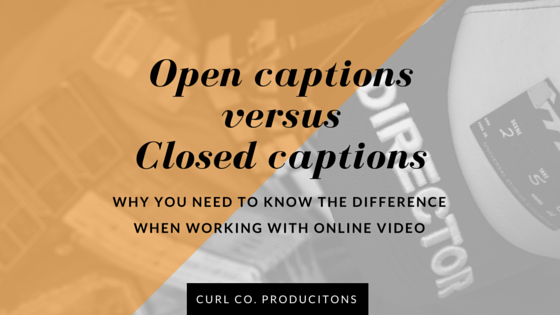Client: Mr Wolf & Nestlé
Brand: KitKat
Creative Director: Steve Liu
Open Versus Closed Captions
Why you need to know the difference when working with online video
Captioning videos has become more and more mainstream with online video with the advent of autoplay, soundless videos, allowing everyone from the hearing impaired to the average Joe scrolling through Facebook to enjoy a video without hearing it and with this has come the popularity of designer subtitles and captions – you can read about this in my post; Designer Subtitles. Let me clarify one thing before continuing, there is a difference between subtitles and captions which you may be aware of, a difference I outline in my post; The Difference Between Subtitles and Captions, but know that these pros and cons more-or-less apply to both captions and subtitles. What you may not know is the different categories of captions, what they mean for viewers and what they mean for video producers and brands, that is what we will address here.

Closed captions is probably a term familiar to most, these are optional, user-activated captions that nowadays tend to be built into the video distribution platform. For example, YouTube offers auto-generated closed captions (where the video is transcribed by computers) and even community contribution (where fans and viewers can transcribe the content personally). An older example from the age of broadcast is tele-text.
You are probably less familiar with open captions as it tends to be a term thrown around by video professionals. This is because there is no need for user activation, open captions are rendered or “baked” into the footage like the opening titles, or credits are.
As I said earlier each has their pros and cons. Closed captions are optional for the user, this can be a good and a bad thing. My husband hates having captions when they are unnecessary and it this way the closed caption is good, giving him the option to turn them off. The flips side of this, however, is that user-activation tends to require know-how or web-savviness from the viewers which, depending on your audience, may be asking too much. Another pro to closed captions is their ease of editability, if YouTube’s auto-generated captions aren’t correct, a quick jump into the Creator’s Studio and you can make the necessary changes. Then there is the aesthetic: closed captions are ugly, they were designed for readability at a time when the fonts available were limited and have since maintained that legacy. There are a few other pros and cons which I have listed below
Pros of closed captions:
- User decides if on or off
- Easy to edit at anytime
- Auto-generation and community generation options
- Readability is more or less guaranteed
- If there are mistakes it is generally accepted/overlooked by audiences
Cons of closed captions:
- May require audience know-how to turn on
- In most cases are ugly
- Caption timing can be out of sync with visuals
- Auto-generation can be poorly transcribed depending on the technology and the audio (volume, background noise, and accents can render the auto-gen useless and in some cases quite funny)
- Community generation can open your videos up to trolls and spam
- No choice with positioning of the words – may cover key action
- Don’t necessarily default to ‘on’ with audio-free autoplay videos – some platforms allow users to default captions on
Open captions, as mentioned above, are “baked” into the video making it a lot more work to edit them and in some cases it may require getting your motion designer or video editor to jump back into the project, make the changes, re-export and then re-upload. This means, with something like YouTube you are starting back at 0 views with each new version uploaded. Saying this they are effortless for viewers to use, simply appearing for them whether the video is auto playing without audio on Facebook, or blasting out someone’s phone on the train, and they have the ability to be nicely designed, smoothly transitioned and “on brand.”
Pros of open captions:
- Does not require users to do anything to activate
- Have the ability to look fantastic
- Another opportunity to drive home branding
- Can be designed around key action to ensure not distracting or overlapping
- Safe from trolls, vandals, and spam (at least in the captions, no one is ever truly safe in the comments section)
- Human judgement and context cues can be taken on board when transcribing different accents and poor audio
- Video can be enjoyed and understood with audio-free autoplay videos
Cons of open captions:
- Can be difficult or time-consuming to edit – in some cases requiring a motion designer or video editor
- If changes are made to a video already live, the file will need to be replaced, as with Vimeo, or uploaded as a new video, starting back at 0 views, as with YouTube
- If poorly designed can be hard to read
- User gets no decision and cannot turn off if preferred
- If mistakes are made these are less forgiven by viewers, especially the spelling fanatics and grammar pedants amongst us
So, it is a battle, do you value the ease of use and legacy of closed captions or the flexibility and professionalism of open captions. I think it is important to consider your audience, their needs, their preferences and the platform you are using to distribute your content. This should inform your decision and ensure you are making the most out of your captions.